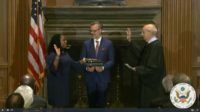Reversing a long-standing interpretation of its own regulations, the U.S. Environmental Protection Agency has issued "guidance" to its regional offices and states and seeks public comment on its intent to ease air-pollution permit rules for facility construction under the federal Clean Air Act.
The guidance, sent March 25, would allow work to begin on major projects that would be new stationary air pollution sources—such as power plants, industrial boilers and manufacturing facilities, or modifications to those—before obtaining preconstruction permits required under the federal law's New Source Review program.
That program is a set of regulations under the law to protect public health and the environment from air pollution when major new air emissions sources are built or modified.
Most states administer their own programs under the law, but some are EPA-managed, according to the program website.
Industry groups and construction firms say EPA’s draft guidance would enable projects on tight timelines to move forward in a timely manner, particularly those that are non-controversial.
In the guidance document released by Anne Idsal, EPA principal deputy assistant administrator, the agency asserts that earlier interpretations of its regulations were too narrow, impeding source owners or operators from starting any construction activity on a project site.
Idsal's new guidance contends that in the past, EPA has considered “almost every physical on-site construction activity that is of a permanent nature to constitute the beginning of ‘actual construction.’”
Industry groups have chaffed under that interpretation, saying it is overly restrictive and prevents projects on a tight timeline from moving forward expeditiously.
In her new guidance to clean-air administrators, Idsal said the policy change is not subject to the normal public notice and comment period associated with a new rule. But EPA is allowing public comment on this through May 11.
As the guidance document is non-binding, however, state air administrators that oversee construction permitting have significant latitude as to whether they must follow it.
Environmental groups contend the policy change is just the latest in a series of moves by the Trump administration to roll back important environmental protections under the NSR construction permitting program.
The Harvard Environmental and Energy Law Program says that since 2017, EPA has issued notices, memoranda, guidance and letters that narrowed the definition of what “sources” are, limited pollution considered during the NSR review process, and did not enforce the program consistently. The Harvard program equates this to a near dismantling of the program.
The new proposed guidance will allow construction to begin—even on structures that are costly and potentially difficult to remove—as long as no work starts on an actual emissions unit.
EPA adds that any owner that begins construction on a project without a permit does so at its own risk.
Mike Rinkol, environmental services lead at Overland Park, Kan.-based Black & Veatch, says some projects would benefit from EPA’s proposed approach. “On certain projects, if schedules are really tight, this allows [the contractors] to get on site” and do some preliminary work, he says.
Janet McCabe, former acting assistant administrator for EPA's Office of Air and Radiation during the second Obama administration and now director of Indiana University’s Environmental Resilience Institute, says the new guidance doesn’t consider that “if a company has already sunk a lot of capital into a project, it’s very hard [for a permit authority] to say no to a permit.
Additionally, once foundations and permanent structures begin to be put in place, technologies available for emissions control may be more limited.
Implementing some of the best available control technologies required under the clean-air law might not be possible on a project already well underway, McCabe says, or they would be more expensive because of the way the structure has been built.
“Your options are much more open” before construction begins, she adds.





